Beginners Guide to The Blues
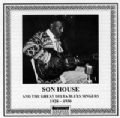
1. Son House and The Delta Blues Singers ~ Great Delta blues.
DOCD-5002
A selection of earthy country blues with spine tingling performances form Son House's early Paramount recordings. Wonderful country blues from Robert Johnson's "Friend Willie Brown" as mentioned in Johnson's classic 'Crossroads Blues'. Includes the hypnotic rhythms of Garfield Akers.
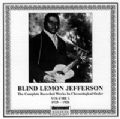
2. Blind Lemon Jefferson Volume 1
DOCD-5017
For many, the original guitar hero, (though some would argue that it was Sylvester Weaver). Jefferson was the first male "country blues" artist to find fame through the release of his records far beyond his home state of Texas. His imaginative lyrics were accompanied by amazing guitar licks that influenced a fine pedigree of blues guitarists. What Robert Johnson was to the modern slide guitar sound of Elmore James and beyond, so Blind Lemon's style was to straight, sophisticated, fingering of from Lightnin' Hopkins to T Bone Walker, Buddy Guy and BB King.
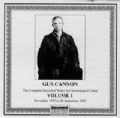
3. Gus Cannon Volume 1
DOCD-5032
Early solo tracks by Gus Cannon plus 15 track by Gus Cannon's Jug Stompers. Cannon spent his youth playing in Medicine Shows becoming an outstanding performer. Early recordings include his version of Poor Boy (accompanied by Blind Blake) with Cannon playing with a slide (in his case using a pen knife) flat on his lap. The only recording of a banjo being played with a slide as far as we can tell (that's 'cos it ain't easy to make a banjo sound dead by using a slide). Cannon's Jug Stompers' recordings are so accessible from a listening point of view. A magic formula that makes one feel good and as if all is well with the world. Who says that blues is depressing?
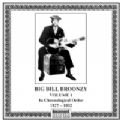
4. Big Bill Broonzy Volume 1 DOCD-5050
There are a lot of very regal titles given to blues artists; King of this and Queen of... Empress of...etc. The status of Big Bill Broonzy as a bluesman, recording artist and performer throughout his career was certainly up there. His significance in the history of the blues music and rock has been of enormous significance; influencing many, from Muddy Waters, Jimi Hendrix, Johnny Winter, Rory Gallagher and being among the first blues artists to take the music out of the States over to Europe. He was also able to embrace and transcend the changing styles of the blues from pre-war "country blues" to post-war electric blues which he played a significant part in pioneering and he was a central figure in the popular acoustic "folk blues" of the 50's which helped to ignite the first major blues revival which took place in the 1960s. This CD presents Big Bill's first recordings which demonstrate his prowess as a guitar player second to none. Finger twisting rags, machine gun firing, flat picking on 'How You Want It Done?' and low down blues from Mississippi are all part of these stunning performances.
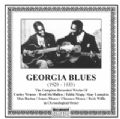
5. Georgia Blues
DOCD-5110
The blues can be dissected in many ways but as a new comer to the music it is the regional styles which soon become apparent and it is fascinating how rich and varied they are. Obvious or regional styles which seem to find favour are Mississippi with it's pulsating rhythms and heavy beats, the more delicate lyrical and ragtime style of the Piedmont area of the Carolina's and Virginia, or the melting pot of the electric blues of Chicago. The Georgia blues scene was created from a tight knit community of musicians with iconic figures such as Blind Willie McTell and Barbecue Bob. This CD comprises of part of those that made up the blues scene of pre-war Georgia and in particular, Atlanta. Some excellent performances here including the dark and mesmerising 'Wait and Listen' by Fred McMullen and the frenetic 'No No Blues' by McTell's close friend Curley Weaver.
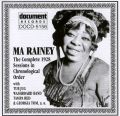
6. Ma Rainey Volume 5
DOCD-5156
It was the so called "Classic Blues" that was the first blues to be recorded. This genre is typified by being performed by a female blues singer accompanied by a small jazz band. The "Classic Blues" format dominated blues recording from its first release in 1920 to 1926 when male "Country Blues" artists such as Blind Lemon Jefferson hit the scene. Other males artists including Ed Andrews, Papa Charlie Jackson, Daddy Stovepipe and Sylvester Weaver had recorded prior to Jefferson but their impact was not as significant to his and to the subsequent avalanche of Country Blues recordings made in 1927 and the following decade. The most obvious name that comes to mind is Bessie Smith who during her recording career and following her tragic, premature death has been revered by many and in particular jazz collectors and historians as being the epitome of the style. Though Bessie was certainly excellent with her powerful singing, one must go to one of the main sources of her talent, Ma Rainey. To a great extent Ma was overshadowed by her protégée yet it can be argued that she was the best and this volume finds her providing some of her best. Who better to introduce jazz and blues newcomers to the "Classic Blues".
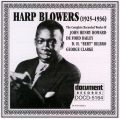
7. Harp Blowers
DOCD-5164
Bob Hite, singer in Canned Heat called it "the Mississippi Saxophone" and by the time Little Walter got a harmonica, his hand, jamming a heavily amplified microphone up to the back of it, there could not be a better description. Like the banjo, the harmonica or harp was there from very early on. Light and easy to carry around it was the instrument of many an itinerant musician. The CD brings together four exponents of blues harp playing with masterly, showpiece performances. No blues harp CD would be worth it's weight in plastic without train inspired instrumentals and 'Pan American Express' and 'C & N W Blues' take care of that in grand style. Other blues harmonica standards, such as John Henry and Fox Chase also appear, contributing to an excellent taster of big blues performances blown throw this small but potent instrument.
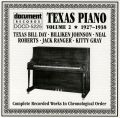
8. Texas Piano Volume Piano DOCD-5225
As with regional styles, instruments have been synonymous with areas of the blues geographical map. Mississippi blues are predominantly guitar based, the twelve string guitar was, for some time favoured in Atlanta, Georgia. Apart from some excellent guitarist from both regions, St Louis and Texas produced distinctive piano styles. This CD takes the listener into the realm of barrelhouses, dusty floors, hot summer days and juke joint nights. Texas Bill Day and Jack Ranger's recordings are fine examples of the genre with Kitty Gray turning up the tempo with her infectious swing approach. A fine intro to piano blues.
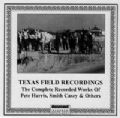
9. Texas Field Recordings
DOCD-5231
Sooner rather than later blues collectors ponder on the amount of recordings that were made during the halcyon days of recording during the pre-war period between the 1920s and 40's. Many artists were recorded on a try it and see basis by the recording companies. Unknowns became well knowns but many soon slipped back into obscurity, leaving collectors and fans alike wondering how many good artists slipped through the net trawled by the record companies. Apart from the non- commercial, academic, documentary purpose which laid behind the fascinating field recordings made for the Library of Congress, they give a tantalising glimpse of what lay beyond the reaches of the recording studios and equipment of commercial labels. The vast majority of the field recordings found within the Document Catalogue are absolute gems. In some cases artists were found who had already recorded commercially such as Oscar Woods, Bukka White Son House and Jelly Roll Morton. Others were recorded for the first time as unknowns but went on to to become significant artists including Lead Belly, Muddy Waters, Honeyboy Edwards, and Buster Brown. Recorded in Texas Prisons this CD is an excellent example of recordings capturing (no pun intended) some excellent musicians who would have more than qualified for being recorded commercially. Some stunning slide guitar by Pete Smith, typical and driving, Texan guitar rhythms, push Pete Harris along.
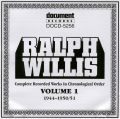
10. Ralph Willis Volume 1
DOCD-5256
With something in the order of 24,000 tracks and counting It goes without saying that there are going to be many unexpected discoveries in the Document catalogue for novices and more experienced collectors and fans alike. Ralph Willis is among them. The CDs presented here first appeared on the Blues Classics label, yet even though the recordings presented on this and the subsequent album have been around for some time the name of Ralph Willis does not instantly spring to mind when names are being discussed in the blues world. Yet this CD and the second volume cannot be recommended highly enough. His post-war style of Country Blues which also lean towards electric "Down Home" style, demonstrates the rudimentary development of one style's progression towards a more modern style, rather like the early recordings of Arthur "Big Boy" Crudup from Mississippi. From the eastern states’ style, Willis is in turn influenced, to some degree, by the older style of Blind Boy Fuller and is joined on some of his recordings by his contemporary, Brownie McGhee. There are some excellent blues here with some well paced performances by an artist who has been woefully side tracked. A must for anyone, all collectors and those taking there first tentative steps into this music.
We hope you have found our Beginners Guide to The Blues useful, giving the first overview of the Document Records back catalogue.


